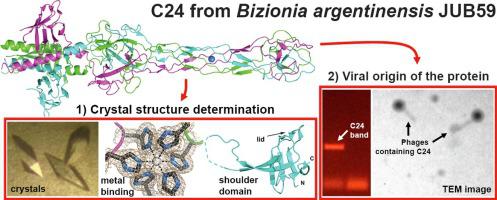Journal of Structural Biology ( IF 3 ) Pub Date : 2020-07-28 , DOI: 10.1016/j.jsb.2020.107595 Leonardo Pellizza 1 , José L López 2 , Susana Vázquez 3 , Gabriela Sycz 1 , Beatriz G Guimarães 4 , Jimena Rinaldi 1 , Fernando A Goldbaum 5 , Martín Aran 1 , Walter P Mac Cormack 6 , Sebastián Klinke 5

|
Tailed bacteriophages are one of the most widespread biological entities on Earth. Their singular structures, such as spikes or fibers are of special interest given their potential use in a wide range of biotechnological applications. In particular, the long fibers present at the termini of the T4 phage tail have been studied in detail and are important for host recognition and adsorption. Although significant progress has been made in elucidating structural mechanisms of model phages, the high-resolution structural description of the vast population of marine phages is still unexplored. In this context, we present here the crystal structure of C24, a putative receptor-binding tip-like protein from Bizionia argentinensis JUB59, a psychrotolerant bacterium isolated from the marine surface waters of Potter Cove, Antarctica. The structure resembles the receptor-binding tip from the bacteriophage T4 long tail fiber yet showing marked differences in its domain organization, size, sequence identity and metal binding nature. We confirmed the viral origin of C24 by induction experiments using mitomycin C. Our results reveal the presence of a novel uncharacterized prophage in the genome of B. argentinensis JUB59, whose morphology is compatible with the order Caudovirales and that carries the nucleotide sequence of C24 in its genome. This work provides valuable information to expand our current knowledge on the viral machinery prevalent in the oceans.
中文翻译:

来自南极细菌 Bizionia argentinensis JUB59 的新型温带噬菌体的假定长尾纤维受体结合尖端的结构。
有尾噬菌体是地球上分布最广的生物实体之一。考虑到它们在广泛的生物技术应用中的潜在用途,它们的独特结构(例如尖峰或纤维)特别令人感兴趣。特别是,存在于 T4 噬菌体尾部末端的长纤维已被详细研究,并且对于宿主识别和吸附很重要。尽管在阐明模型噬菌体的结构机制方面取得了重大进展,但对大量海洋噬菌体的高分辨率结构描述仍未得到探索。在此背景下,我们在此展示了 C24 的晶体结构,C24 是一种来自阿根廷 Bizionia的推定受体结合尖端样蛋白JUB59,一种从南极洲波特湾海洋表层水中分离的耐冷细菌。该结构类似于来自噬菌体 T4 长尾纤维的受体结合尖端,但其结构域组织、大小、序列同一性和金属结合性质显示出显着差异。我们通过使用丝裂霉素 C 的诱导实验证实了 C24 的病毒来源。我们的结果揭示了阿根廷芽孢杆菌 JUB59基因组中存在一种新的未表征的原噬菌体,其形态与尾状病毒目兼容,并且携带 C24 的核苷酸序列它的基因组。这项工作提供了宝贵的信息,以扩展我们目前对海洋中流行的病毒机制的了解。


























 京公网安备 11010802027423号
京公网安备 11010802027423号